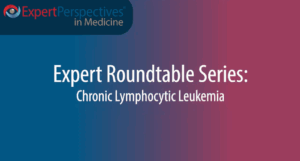Oncology
Chronic Lymphocytic Leukemia
Examining the Effect of Treatment Tolerability on Survival Outcomes in Chronic Lymphocytic Leukemia
If a patient needs therapy but cannot tolerate it, that is obviously not good, as needing to stop treatment due to toxicity has a large impact on outcomes. A good example of this is the early-generation BTK inhibitor ibrutinib. In the clinical trial setting, some patients with CLL are able to stay on the drug for as long as 10 years. In the real-world setting, however, we find that many patients, especially those who would not have been eligible for clinical trial participation, need to discontinue treatment.
<br>
Of the side effects that we see with ibrutinib, hypertension, bleeding risks, and cardiac arrhythmias are the ones that I worry most about. Other problematic effects that can make patients want to stop treatment include joint issues, ligament and tendon issues, and inflammation. I have seen better success with the next-generation BTK inhibitors acalabrutinib and zanubrutinib. If you do need to change treatments, you can often switch to another drug within the same class and get activity with better tolerability.
<br>
If a patient with CLL is expected to receive a treatment until disease progression, and progression might not occur for 10 years, treatment can last for a long time. It also can be very expensive and cause financial hardship. When choosing treatment for CLL, I am mostly considering tolerability and duration of therapy, as well as patient factors such as hypertension, bleeding, and cardiac issues.
<br>
I think that measurable residual disease and time-limited therapy may have a role in the future. If patients know that they only need to receive treatment for 6 or 12 months, they may be more likely to be adherent to treatment than they would be if they know that they need to receive it for years, until progression.
As Dr Maloney described, tolerability is linked to treatment adherence. Further, an exploratory analysis of the first RESONATE study found that progression-free survival was better among patients on ibrutinib when the dose intensity was at least 80%. Patients need to understand that better adherence means better results, and this is particularly important for a therapy that is taken at home. In addition to the major toxicities of targeted therapy, there are also annoying chronic toxicities that can include fatigue, changes in bowel function, joint pain, and not being able to leave the house until the patient feels good enough to face the day. Those can really affect adherence.
<br>
The good news is that the more we use the targeted therapy, the better familiarity we have with the side-effect profile, and the better we can modify, adjust, and really individualize the agent that we are choosing. We have 3 good BTK inhibitors for CLL, and we can easily modify treatment after toxicity and switch to another drug in the class, potentially seeing a resolution or an improvement in the toxicity.
<br>
I think that having a partnership with patients and using a multidisciplinary approach are really important. At my institution, we have a clinic that is run by a pharmacist. When a patient starts a targeted therapy, the pharmacist calls the patient regularly on the phone to coach them through treatment. We also have cardiologists and rheumatologists involved, and we have survivorship programs in which people offer advice on diet and exercise. All of these can improve the partnership and, ultimately, the results that patients experience from treatment.
When we treated CLL with chemoimmunotherapy, treatment typically only lasted for 6 months. However, there were long-term risks associated with chemoimmunotherapy, with some patients continuing to have low levels of immunoglobulins, persistent cytopenia, and a risk of myelodysplastic syndromes (MDS) and acute myeloid leukemia (AML). Now, we are mostly using targeted therapies such as BTK inhibitors, which are meant to be given long-term. BTK inhibitors increase the risk of hypertension, atrial fibrillation, and bleeding complications.
<br>
On the flip side, time-limited approaches such as venetoclax are generally given for only 1 to 2 years. While patients are receiving treatment, there is a short-term risk of increased myelosuppression, especially neutropenia, which can generally be managed with growth factor support or dose reductions. When patients finish therapy, we typically do not see long-term cytopenias or other side effects. Some patients do remain hypogammaglobulinemic after therapy, although their CLL may be well controlled. Some patients with hypogammaglobulinemia have significant recurrent infections that require monthly intravenous immunoglobulin supplementation, although individuals who do not have significant infections typically do not receive it.
<br>
We must remain aware of the potential long-term side effects of all the therapies that we use for CLL, but, thankfully, the new targeted therapies have a much lower risk of the dreaded complications that can occur with chemoimmunotherapy, such as MDS and AML.
Barrientos JC, Ayed AO, Cha A, et al. Results from a real-world multicenter analysis of 482 patients with chronic lymphocytic leukemia treated with ibrutinib: a look at racial differences. Target Oncol. 2023;18(5):727-734. doi:10.1007/s11523-023-00988-0
<br>
Barr PM, Brown JR, Hillmen P, et al. Impact of ibrutinib dose adherence on therapeutic efficacy in patients with previously treated CLL/SLL. Blood. 2017;129(19):2612-2615. doi:10.1182/blood-2016-12-737346
<br>
Brown JR, Eichhorst B, Hillmen P, et al. Zanubrutinib or ibrutinib in relapsed or refractory chronic lymphocytic leukemia. N Engl J Med. 2023;388(4):319-332. doi:10.1056/NEJMoa2211582
<br>
Byrd JC, Hillmen P, Ghia P, et al. Acalabrutinib versus ibrutinib in previously treated chronic lymphocytic leukemia: results of the first randomized phase III trial. J Clin Oncol. 2021;39(31):3441-3452. doi:10.1200/JCO.21.01210
<br>
Khelifi RS, Huang SJ, Savage KJ, et al. Population-level impact of ibrutinib for chronic lymphocytic leukemia in British Columbia, Canada. Leuk Lymphoma. 2023;64(6):1129-1138. doi:10.1080/10428194.2023.2199340
<br>
Mato AR, Nabhan C, Thompson MC, et al. Toxicities and outcomes of 616 ibrutinib-treated patients in the United States: a real-world analysis. Haematologica. 2018;103(5):874-879. doi:10.3324/haematol.2017.182907
<br>
Molica S, Allsup D. Chronic lymphocytic leukemia care and beyond: navigating the needs of long-term survivors. Cancers (Basel). 2025;17(1):119. doi:10.3390/cancers17010119
<br>
Soumerai JD, Yousif Z, Gift T, et al. IgG testing, immunoglobulin replacement therapy, and infection outcomes in patients with CLL or NHL: real-world evidence. Blood Adv. 2024;8(16):4239-4249. doi:10.1182/bloodadvances.2024013073
<br>
Wierda WG, Tambaro FP. How I manage CLL with venetoclax-based treatments. Blood. 2020;135(17):1421-1427. doi:10.1182/blood.2019002841













